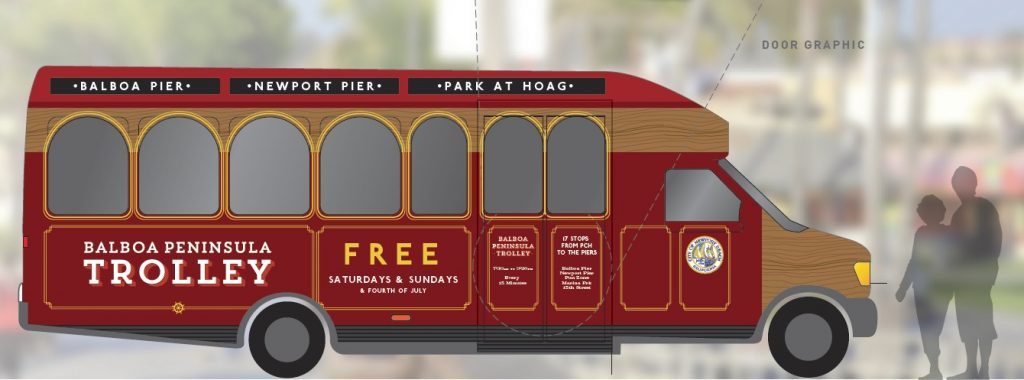
— Courtesy of the city of Newport Beach ©
A new way to travel up and down the Balboa Peninsula will be available for visitors and locals alike this summer, following a Newport Beach City Council decision this week.
Council voted 5-2 to approve the Balboa Peninsula Trolley, a free shuttle that will run for 12 weekends this summer, as well as the fourth of July holiday, starting June 17 and ending Sept. 3.
It’s just a one-year trial run, officials emphasized. The agreement with the chosen vendor, Signal Hill-based Professional Parking, includes an option to renew in subsequent years through 2023.
Supporters hope it will help alleviate traffic, free up parking and bring more people to the businesses in the area.
“I’m for any idea we can come up with to reduce traffic and bring more business to the businesses down there,” in Balboa Village, Councilman Brad Avery said. “It’s expensive, but I think, ultimately, it’s the kind of thing the city should be supporting.”
It’s a great opportunity, agreed Mayor Pro Tem Marshall “Duffy” Duffield.
“At the end of the day, we’re all looking to figure out how in the heck we can solve the parking problems on the peninsula,” Duffield said. “This is a pilot program, it will come, we’ll get the data, we’ll learn from it.”
Riders may park free at the lower parking lot at Hoag Memorial Hospital Presbyterian and board the trolley. There are about 40 spots available at the hospital, but there is the option to expand if needed, noted Deputy Community Development Director Brenda Wisneski. Hoag is charging the city $5 per day, per spot, she added.
Staff also anticipates that people will jump on and off at the other stops along the peninsula. A feasibility study estimated the shuttle will see approximately 437 daily riders.
Shuttle stops will occur every 15 minutes at 10 locations along the Peninsula, ending at Balboa Village. A phone app will be available for riders to locate the shuttle along the route so they can plan their pick-up. Service will be from 7:30 a.m. to 9:30 p.m.
“With the use of a parking facility located off the peninsula, visitors could avoid having to hunt for parking, while residents could avoid using their vehicles (and save their parking spots),” staff concluded in the report.
Councilwoman Diane Dixon, who represents District 1, which covers the Balboa Peninsula, said the program was a community effort.
“The Peninsula Trolley pilot program brings together government, residents and private business to improve a situation facing all of us in Newport Beach and that’s traffic congestion,” Dixon said. “It fits perfectly in our long range planning recommendations for the peninsula businesses and resident groups.”
But not everyone saw eye-to-eye on the issue. Mayor Kevin Muldoon and Councilman Scott Peotter dissented.
Peotter was on the fence about the program and felt the typical visitor would not use the trolley and ultimately voted against the item.
“It seems like a bad investment for taxpayers, (although) it might be a good investment for the city of Newport Beach,” Peotter said.
City staff previously secured an Orange County Transportation Authority competitive grant for Measure M funds, which is Orange County’s “half-cent transportation sales tax,” as described by the OCTA.
The cost of the contract for four shuttles for the first year is $116,910, with 88 percent of that funded by the OCTA grant.
The remaining $14,029 will be paid for by the city through Balboa Village Parking revenues. Those funds are targeted toward supplementing the services within Balboa Village and the surrounding area, Wisneski said, and they can go toward transit, streetscape, pedestrian and bike infrastructure, parking, or other uses.
“This program is perfectly suited for those parking funds,” she said.
Marketing and signage costs also have to be factored in, which are also eligible expenditures from the OCTA grant.
There are also some added costs that are not being reimbursed by OCTA because they were not part of the original grant application, like extra marketing and signage and slurring and striping the parking lot, Wisneski noted.
Total city funds spent “out the door” to get the trial run started this year would be about $68,000, explained Assistant City Engineer Mike Sinacori.
“The intent is to get as much paid for by OCTA,” as possible, Sinacori said. “We’re going to try our best to get every cost, up to 88 percent, covered.”
Staff is still working with OCTA on adjusting the actual numbers within the grant, Sinacori added, and they will continue doing that throughout the program. If a cost increases in one area, they will try and get OCTA to pay up to 88 percent of the cost of it, he added.
Peotter asked about the cost per rider, which city staff confirmed would be approximately $10.70 per passenger, based on the shuttle’s total operating costs and the anticipated riders per day. Including the total upfront marketing and one-time signage costs, that figure per passenger would just about double, Peotter pointed out.
Although the marketing and signage cost projections go “significantly down” each year following the initial trial run, he added.
Muldoon voted against the project primarily because the most amazing milestones being accomplished in transportation are by the private sector.
Opponents have raised concerns that the trolley will compete with the other free shuttle service on the peninsula, the Downtowner.
“This doesn’t make sense,” resident Mike Glenn pointed out. “This doesn’t provide anything that the Downtowner doesn’t already provide in the free market, costing both taxpayers and riders zero dollars.”
Other cities are looking to outsource transportation services to Uber, he pointed out, and busses are canceling their routes to the peninsula because of low ridership.
“I’m on the peninsula, I see who takes the bus, it’s nobody,” Glenn said.
It will also “snarl” traffic and congest the peninsula even more, he noted.
There are traffic and parking problems on the peninsula, agreed resident Ashley Jacobs, but the proposed trolley is not the answer.
“I don’t think that replacing a failing mousetrap in the form of OCTA busses with a very similar mousetrap of trolleys or shuttles – or whatever it’s going to be this year – is the best way to help alleviate these problems,” Jacobs said. “I think we can come up with a better mousetrap.”
Taking 40 cars off the road, or even 100, isn’t going to make much of a dent in the situation, she said. The thousands of cars that actually create the problem will now be stuck behind a trolley making a number of stops in difficult locations along the street.
“This isn’t going to fix any problems,” Jacobs said. “I don’t have the solutions for it, but I think we can come up with something better that makes a lot more sense that isn’t a waste of money.”
A handful of other residents spoke during public comment, but most liked the idea of the trolley. People supporting the project said it will help with traffic, parking and business on the peninsula.
Maureen Cotton, president of the Central Newport Beach Community Association, strongly supported the trolley.
“This is a really big deal,” Cotton said. “It’s really, really important to the Balboa Village.”
It will increase the “mobility” of people, particularly locals, said another Balboa Peninsula resident.
On busy summer days, Cotton and many of her neighbors all “hunker down,” she said. If they have to go out, they go by bicycle and use the alleys to avoid all the traffic and keep their parking spot near their homes, Cotton added.
The Balboa Peninsula Trolley means that locals can actually get out without worrying, she said.
It will reduce the number of cars on the peninsula while still encouraging people to shop and visit the peninsula, added another local speaker.
“We have a big dynamic of people coming down and the one thing they all need is a parking spot,” said another Balboa Village business owner.
Monitoring the program will be vital, staff, residents and council agreed. The operator will track ridership and gauge interest, the city will review if any modifications are needed to increase efficiency, and OCTA thresholds will determine whether it was successful or not at the end of the summer.
“We’ll see if we have a viable program to go forward in the future,” Sinacori said.
Councilman Jeff Herdman suggested the council receive an update on the program midway through summer.
“I’d like to see how things are going,” Herdman said. “What the response from the community is.”
He wants to keep a close eye on the program particularly because he has been “inundated” with emails from Balboa Peninsula residents who are not in favor of the trolley, he noted.
Herdman added that he still would support trying it out for one summer.
“I think it deserves a trial,” Herdman said.
After the vote, Cotton said she was happy with the result.
“Quite frankly, it needs to happen,” Cotton said.




